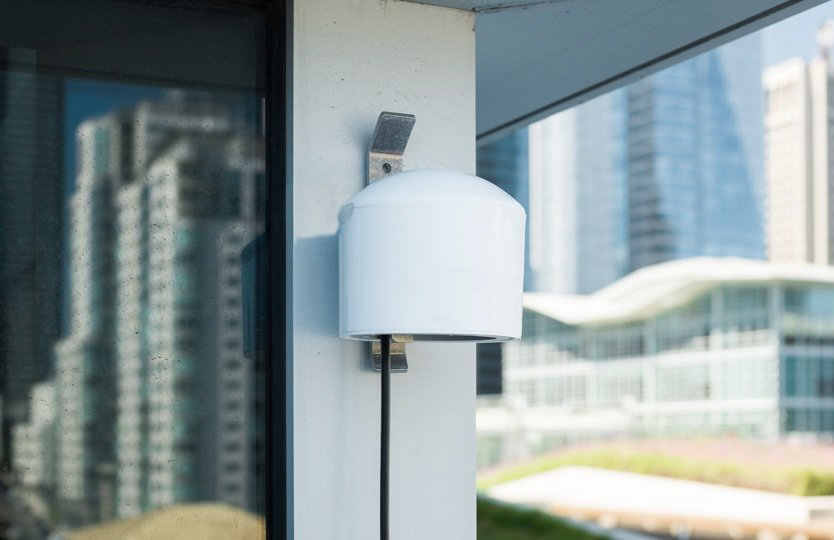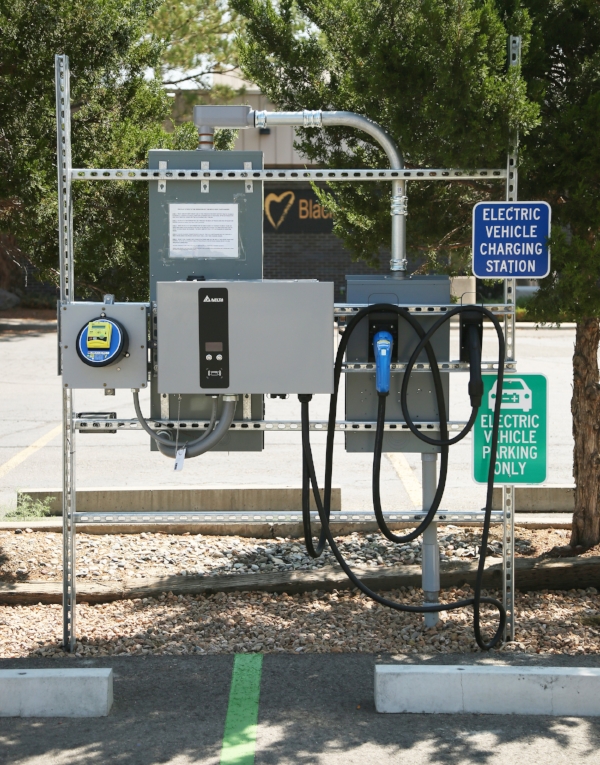Eco Series Part 2: Air Care in the Grand Valley
Colorado National Monument in Grand Junction / Photography by Cat Mayer
Some people move to the Grand Valley to escape big-city problems and enjoy a better quality of life, with air quality as part of the equation. The American Lung Association lists Grand Junction among the 25 cleanest cities for annual air particle pollution, and grades it much better than both Denver and Salt Lake City. Still, there are opportunities for improvement.
At certain times of year, the area topography of the Book Cliffs, Grand Mesa, and Colorado National Monument creates a natural trap for air pollution, and winter inversions act like a “lid on the top,” says Citizens for Clean Air (CCA) spokeswoman Kristin Winn.
Formed 5 years ago, CCA works to promote clean air as a public health benefit and to examine the causes of Western Slope air pollution. They also promote grassroots involvement with local, state, and federal efforts to mitigate the effects of air pollutants.
Winn recalls what seemed like a winter-long inversion in 2013 that made viewing the Book Cliffs from the Grand Junction Area Chamber of Commerce visitor center off Horizon Drive very difficult. This past summer had several days of high levels of particulates in the valley from wildfires burning on the Western Slope and in several western states.
“Global warming [contributes to] more and larger fires, and the prevailing winds bring all that smoke to our valley,” Winn says.
Purple Air device
Purple Air Keeps Tabs on the Valley
Though particulate concentrations can differ dramatically across the valley, there is only one EPA-approved particulates monitor within the Grand Junction airshed. CCA felt this limited an understanding of what was happening in the air throughout the valley, as well as the ability to provide quality data to address community health concerns.
Even short-term exposure to high levels of particulates can cause problems, especially for children, the elderly, and those with respiratory and other ailments. “Studies show 7 million people die each year from air quality-related illnesses worldwide,” Winn says.
To combat these issues, in mid-March the group launched the Purple Air Monitoring Project. The project was spearheaded by Gerald C. Nelson. The Illinois professor relocated to Grand Junction in 2012 for its clean air and sunshine, joining Citizens for Clean Air soon after.
Nelson researched and tested low-cost air quality monitors to measure particulate matter like dust, wood smoke, and smoke from open burning. He recommended the purchase of monitors from a company called Purple Air, at a cost of $200 each on orders of 10 monitors. The group obtained funds from Conservation Colorado, the Western Colorado Community Foundation, and Desert Ecosystems and Restoration.
The Book Cliffs view from Saddlehorn Campground at Colorado National Monument
By late summer 2018, more than 30 monitors were installed across the valley — from Mack to Palisade, and from northern Grand Junction to Whitewater. Alpine Bank placed monitors at each of their five Mesa County locations, and group members volunteered their homes as monitor sites, Nelson adds.
The group’s website, citizensforcleanair.org, offers citizens access to that data, updated daily. CCA is also working with Mesa County Valley School District 51 to place 20 monitors on district schools.
“Parents can find out what the air quality is at their child’s school, so if he or she has asthma or other breathing difficulties, they can take steps,” Nelson says. “And science classes can use the data to teach.”
Nelson hopes the group can find and obtain grants to purchase monitors with more capabilities, but is pleased with the data gathered to date.
The group notes Grand Valley air pollution comes from many sources, including motor vehicle exhaust, forest fires, wood smoke, methane releases, ozone, road dust, agricultural and construction operations, agricultural and trash burning, and natural gas and oil development.
“Our point was not to point the finger at any one source or a particular location,” Nelson says.
Air Quality is Actually Improving
Jeremy Neustifter, an air quality planner for the Colorado Department of Public Health and Environment, points out all nine counties in the Western Slope region complied with the Clean Air Act in 2016, the latest year with statistics available.
“Even though they’ve always been in compliance, there has been much concern from some people,” Neustifter says.
A 2012 blowing dust climatology report found that while there are sources of wind blown dust within the Grand Valley and Grand Junction, analyses show that regional sources in Utah and Arizona play a significant role in our air quality.
Two Grand Junction air toxics monitors were originally established as part of a 2001-02 National Air Toxics Trends Sites pilot study, created by the EPA to identify trends in air toxics concentration levels. Samples are collected on top of the Powell Building at 650 South Avenue, and on the roof of a small shelter at 645¼ Pitkin Avenue.
Most of the compounds — related to motor vehicle sources — detected in Grand Junction in 2016 were found in urban air nationwide, with no compounds of local significance.
Gas development and associated truck traffic contribute to air quality concerns, Neustifter adds, but at lower levels than people think. “We track all their emissions, and they have very low reporting levels,” he states. “And nearly all their facilities have to have air emission permits from us.”
Neustifter notes Grand Junction and all of Colorado had fewer air quality problems in recent years. “That’s mostly due to more cleaner-fuel-burning vehicles and fewer older, dirty-fuel-burning vehicles,” he says. “So even though the Grand Valley — and Colorado as a whole — has grown, we’ve seen decreases.”
In an effort to combat air pollution and other concerns, the Colorado Air Quality Control Commission voted unanimously in November to adopt statewide low-emission vehicle standards, which may bring even clearer skies to come.
Atlasta’s EV charging station at Mesa County Public Library
More Electric Vehicles = Cleaner Air
Solar power company Atlasta Solar Center is helping to install electric motor vehicle charging stations and encourage the purchase and use of electric cars in the valley. Co-owner Lou Villare says the company wants to reduce carbon dioxide emissions and promote more use of electric vehicles through the Charge Ahead Colorado program.
Colorado is one of a handful of states to use fine money awarded from Volkswagen’s diesel emissions violations to add more EV charging stations. It is focused on new charging stations along Interstates 25 and 70, especially the addition of “fast chargers.” Chargers now have a capacity of 60,000 watts but will soon reach 100,000 watts, Villare says, which would add another 100-200 miles between EV charges.
Atlasta has completed several such projects in the Grand Junction area, including one at the Mesa County Central Library at 443 N. Sixth Street, which hosts a charging station Atlasta hopes to convert to solar power. That station now gets its power through Xcel Energy’s Wind Source program, Villare notes. “We’re working with the City of Delta to locate a downtown station there, too,” he adds.
To date, electric vehicles have seen marginal use by U.S. drivers, Villare says, but he thinks they are becoming more mainstream. “We have solar home owners who buy, say, a Chevy Volt, because they want to eliminate even more emissions when they drive their car,” he says.
Between 60 to 70 percent of the U.S. carbon footprint is caused by the use of electricity and transportation, so if solar power can reduce emissions from those two uses, the footprint should be significantly reduced, Villare points out.
“Most people can get behind owning a solar home based on the savings, and now that EVs can go for 300-400 miles between charges for about the same cost as a car that uses gasoline, why not use the same fuel you get on the roof of your house to power your car?” Villare asks.
Meanwhile, Winn says Citizens for Clean Air has worked on legislative air quality issues, such as testifying in favor of methane leak regulations adopted by state air quality officials. The group also worked with Grand Junction officials to reduce the numbers of open burning months from five to two in the spring and one in the fall. Winn says they hope to convince Mesa County officials of a similar limit.
“We try to tackle things we can control and raise awareness of our situation and what people can do,” she adds. “It will take all of us.”
Easy, Affordable Energy-Saving Tips from Excel Energy
Buy a programmable or smart thermostat to save on energy costs by adjusting the temperature when you’re away or sleeping.
Run a ceiling fan in a clockwise direction to push warm air down from the ceiling. Run it counter-clockwise in the summer to circulate cooler air.
To reduce heating and cooling costs, plant evergreen shrubs or trees on the north side of your home, or to shade your AC unit. Summer temperatures can be 3-6° cooler in tree-shaded neighborhoods than in areas without trees.
High-efficiency LED light bulbs use up to 90 percent less energy and last 15 times longer than traditional bulbs, saving money over the life of a product.
Not using heat in the drying cycle can save up to 20 percent of your dishwasher's total electricity use.
Always wash full loads of clothes to maximize water use and savings.
Add tennis or wool balls to your dryer to help clothes dry faster and save energy.
Set your hot water heater to no higher than 120°. Lowering it 10° saves you 3 to 5 percent on water heating costs.
A water heater insulation blanket can save you 7 to 16 percent in water heating costs, and it can pay for itself in about a year.
Solar Offerings from Local Energy Providers
Xcel Solar*Rewards program
Solar* Rewards Community gives you the opportunity to subscribe to a third-party community solar garden. Once subscribed, you will receive credits on your monthly utilities bill for the solar energy contributed to the Xcel Energy grid.
Net Energy Metering
When you use Net Energy Metering (NEM) and produce more solar energy than you need, the extra energy is added to their grid. Any excess is held in your solar bank for you to use in future months.
Renewable*Connect solar energy program (Waitlist)
Renewable*Connect, delivers solar energy with no equipment necessary. This program is currently at capacity, but Excel is accepting applications for the waitlist.
Additional information can be found here.
Grand Valley Power
Customers can lease a solar panel located on its solar farm so members do not have to install panels at their homes. This allows renters, those unable to invest in solar panels, or anyone concerned about curb appeal to participate in solar energy.




